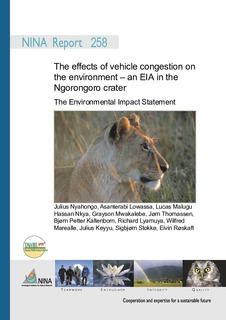| dc.description.abstract | The Ngorongoro Conservation Area Authority (NCAA) faces a great challenge in managing the vehicle congestion in the Ngorongoro crater. They are in need for an assessment of the present situation and realistic plans for mitigating measures and other management actions. The situation is also dealt with in the revised General Management Plan (GMP) for the Ngorongoro Conservation Area (NCA) (NCAA 2006). Tanzania Wildlife Research Institute (TAWIRI) and Norwegian Institute for Nature Research (NINA) collaborate on capacity building, of which Environmental Impact Assessment is one of the tasks. In the capacity building programme it has been decided to use a concrete EIA as a training tool. NCAA, TAWIRI and NINA have decided to use the tourist vehicle congestion in the Ngorongoro Crater as the EIA case in the capacity building programme. Previous reports document the EIA training (Thomassen et al. 2003) and the scoping process (Thomassen et al. 2005). This report, the Environmental Impact Statement (EIS), documents the assessments done, including recommendations and technical reports from the studies conducted. Important recommendations on management actions include the establishment of a zoning system specifying the number of vehicles allowed in each area per day, differentiated fee systems in NCA, and developing a better education and awareness training programme for NCAA staff and tourist drivers. Monitoring recommendations include monitoring of densities and distribution of endangered species and carnivores, flight distances of herbivores and occurrence of invasive species and diseases in NCA. Further, it is recommended to monitor the health condition of the Maasai livestock and the carrying capacity of NCA. Visitor satisfaction should be mapped/monitored every 5th year. Environmental Impact Statement, EIA, AEAM, scoping, capacity building, Ngorongoro crater, Tanzania, Sluttrapport KU, AEAM, scoping, kapasitetsbygging, Ngorongoro krateret, Tanzania | nb_NO |
